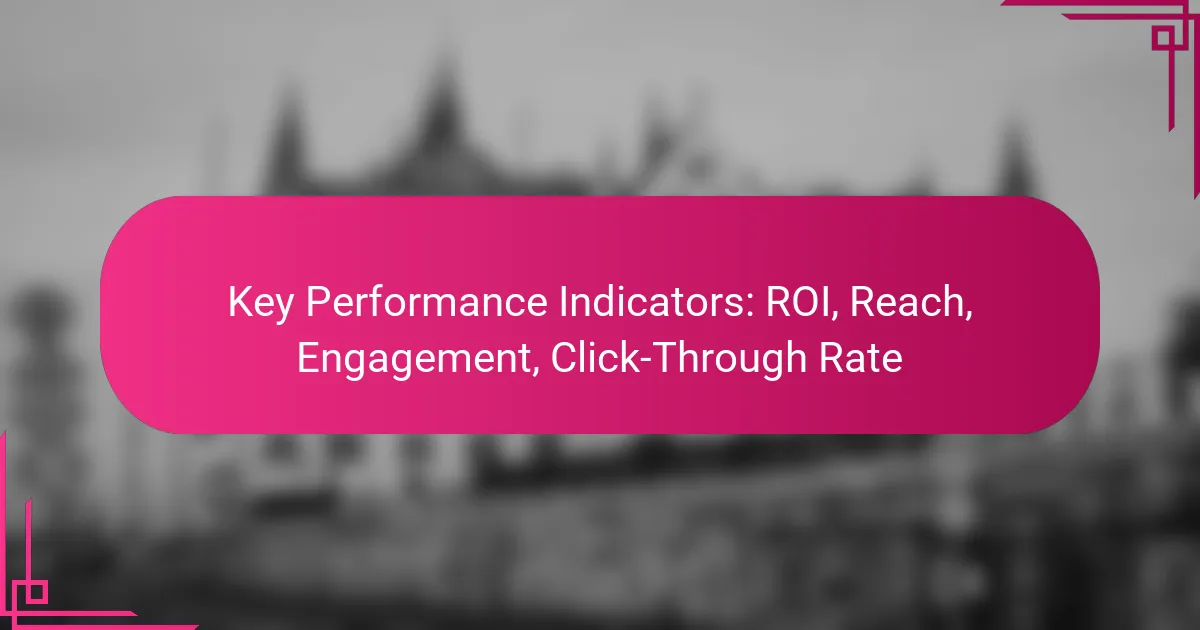Key Performance Indicators (KPIs) are essential metrics that help businesses evaluate the success of their advertising efforts. Metrics such as Return on Investment (ROI), Reach, Engagement, and Click-Through Rate provide valuable insights into campaign effectiveness, audience interaction, and overall performance. By analyzing these indicators, advertisers can make informed decisions to optimize their strategies and enhance their impact in the market.

How to measure ROI in display advertising?
Measuring ROI in display advertising involves evaluating the return on investment generated from ad campaigns relative to their costs. This metric helps advertisers understand the effectiveness of their spending and optimize future campaigns for better performance.
Formula for calculating ROI
The basic formula for calculating ROI is: (Net Profit / Cost of Investment) x 100. In display advertising, net profit is derived from the revenue generated by the ads minus the total cost of the ad campaign.
For example, if a campaign costs $1,000 and generates $3,000 in revenue, the ROI would be: (($3,000 – $1,000) / $1,000) x 100 = 200%. This indicates that for every dollar spent, two dollars were earned in profit.
Tools for tracking ROI
Several tools can help track ROI in display advertising, including Google Analytics, Facebook Ads Manager, and various ad management platforms. These tools provide insights into ad performance, conversion rates, and overall campaign effectiveness.
When choosing a tool, consider factors such as ease of use, integration capabilities, and the specific metrics you want to track. Many platforms offer free trials, allowing you to test their features before committing to a subscription.

What is the importance of reach in advertising?
Reach in advertising is crucial as it measures the total number of unique individuals exposed to a campaign. A higher reach indicates a broader audience, which can lead to increased brand awareness and potential sales.
Definition of reach
Reach refers to the total number of distinct viewers or consumers who see an advertisement over a specific period. It is a key metric in evaluating the effectiveness of advertising campaigns, as it helps determine how many people are aware of a product or service.
In digital marketing, reach can be quantified through various platforms, including social media, websites, and email campaigns. Understanding reach allows marketers to assess the visibility of their content and adjust strategies accordingly.
Impact of reach on campaign success
The impact of reach on campaign success is significant, as a larger reach often correlates with higher engagement and conversion rates. When more people see an advertisement, the likelihood of attracting potential customers increases, leading to better overall performance.
For example, a campaign that reaches thousands of users may generate more clicks and interactions compared to one with limited exposure. However, it’s essential to balance reach with targeting; reaching the right audience is just as important as the number of people reached.
Marketers should regularly analyze reach metrics and adjust their strategies to ensure they are not only reaching a large audience but also engaging the right demographics effectively. This approach maximizes the return on investment and enhances campaign outcomes.

How to improve engagement rates?
Improving engagement rates involves creating content that resonates with your audience and encourages interaction. Focus on understanding your target demographic and tailoring your messaging to their preferences and behaviors.
Strategies for increasing engagement
To boost engagement, consider implementing interactive elements such as polls, quizzes, or user-generated content. These tactics invite participation and can significantly enhance user interaction.
Another effective strategy is to utilize storytelling in your content. Engaging narratives can captivate your audience, making them more likely to share and comment on your posts.
Additionally, optimize your posting schedule based on when your audience is most active. Analyzing engagement data can help you determine the best times to share your content for maximum visibility.
Examples of high-engagement ads
High-engagement ads often feature compelling visuals paired with strong calls to action. For instance, a video ad that tells a relatable story can generate significant viewer interaction and shares.
Another example is a social media ad that encourages users to participate in a challenge or contest. These ads can create a sense of community and prompt users to engage with the brand and each other.
Lastly, ads that incorporate user testimonials or reviews tend to perform well. They build trust and encourage potential customers to engage with the brand by commenting or sharing their experiences.

What is click-through rate (CTR) and why does it matter?
Click-through rate (CTR) is a key performance indicator that measures the percentage of users who click on a specific link compared to the total number of users who view a page, email, or advertisement. It matters because a higher CTR indicates effective messaging and engagement, leading to better conversion rates and overall campaign success.
CTR definition and calculation
CTR is calculated by dividing the number of clicks by the number of impressions and then multiplying by 100 to get a percentage. For example, if an ad receives 100 clicks from 10,000 impressions, the CTR would be (100 / 10,000) * 100, resulting in a 1% CTR.
Understanding CTR helps marketers assess the effectiveness of their campaigns. A typical CTR can vary widely depending on the industry, with average rates often ranging from 1% to 5% for display ads, while email campaigns might see CTRs between 2% and 10%.
Role of CTR in performance evaluation
CTR plays a crucial role in evaluating the performance of digital marketing efforts. A low CTR may indicate that the content is not resonating with the target audience or that the call-to-action is unclear. Conversely, a high CTR suggests that the messaging is compelling and relevant.
Marketers should regularly monitor CTR alongside other metrics like conversion rates and return on investment (ROI) to gain a comprehensive view of campaign effectiveness. Adjustments to targeting, ad copy, or design can be made based on CTR insights to improve overall performance.

What are the best practices for optimizing KPIs?
Optimizing Key Performance Indicators (KPIs) involves establishing clear objectives, regularly assessing performance, and making data-driven adjustments. By focusing on ROI, reach, engagement, and click-through rates, businesses can enhance their strategies and achieve better outcomes.
Setting realistic KPI benchmarks
Establishing realistic KPI benchmarks is crucial for effective performance tracking. Start by analyzing historical data to identify past performance trends, which can inform achievable targets. For instance, if your average click-through rate is around 2%, setting a benchmark of 3% may be ambitious yet attainable.
Consider industry standards when setting these benchmarks. Research typical KPIs for your sector to ensure your targets are competitive. For example, the average ROI in digital marketing can vary widely, often falling between 4:1 and 10:1, depending on the industry.
Regularly reviewing performance metrics
Regularly reviewing performance metrics is essential for staying aligned with your goals. Schedule monthly or quarterly reviews to assess how well your KPIs are being met and identify any areas needing improvement. This practice allows for timely adjustments to strategies based on current data.
Utilize dashboards and reporting tools to visualize performance trends over time. This can help quickly identify patterns or anomalies, such as a sudden drop in engagement rates. Be cautious of relying solely on one metric; instead, consider a combination of KPIs to get a comprehensive view of performance.

How do different industries approach KPI measurement?
Different industries adopt unique strategies for measuring key performance indicators (KPIs) based on their specific goals and customer interactions. Understanding these approaches can help businesses tailor their KPI measurement to enhance performance and drive growth.
Case studies from retail advertising
Retail advertising often focuses on KPIs like return on investment (ROI), customer reach, and engagement rates. For instance, a clothing retailer may track the ROI of a seasonal campaign by comparing sales generated against advertising costs, aiming for a ROI of at least 300%.
Additionally, measuring customer reach through metrics such as foot traffic or online impressions helps retailers understand their audience size. Engagement can be gauged through social media interactions, with successful campaigns often achieving engagement rates of 5-10% on platforms like Instagram.
Insights from tech industry campaigns
In the tech industry, KPI measurement frequently emphasizes click-through rates (CTR) and user engagement metrics. For example, a software company might analyze the CTR of email marketing campaigns, aiming for a benchmark of 2-5% to ensure effective audience targeting.
Moreover, tech firms often utilize A/B testing to refine their campaigns, measuring engagement through user retention rates and feedback. A successful campaign may see retention rates of 30-50%, indicating strong user satisfaction and product value.

What tools can help track advertising KPIs?
Several tools can effectively track advertising KPIs, including Google Analytics and various ad management platforms. These tools provide insights into metrics such as ROI, reach, engagement, and click-through rates, enabling marketers to optimize their campaigns.
Google Analytics for KPI tracking
Google Analytics is a powerful tool for tracking key performance indicators related to website traffic and user behavior. It allows you to monitor metrics such as user engagement, conversion rates, and traffic sources, providing a comprehensive view of your advertising effectiveness.
To get started, set up goals that align with your advertising objectives, such as completed purchases or newsletter sign-ups. Regularly analyze the data to identify trends and adjust your strategies accordingly. Keep in mind that understanding the user journey can help you pinpoint areas for improvement.
Ad management platforms like AdRoll
AdRoll and similar ad management platforms specialize in tracking advertising KPIs across multiple channels. These platforms offer features like retargeting, audience segmentation, and performance analytics, which help you assess the impact of your campaigns on various metrics.
When using AdRoll, focus on setting clear campaign objectives and utilize the platform’s reporting tools to measure success. Pay attention to metrics such as click-through rates and conversion rates to gauge effectiveness. Be cautious of overspending on low-performing ads; regularly review and optimize your campaigns based on the data provided.

What emerging trends are shaping KPI measurement?
Emerging trends in KPI measurement are increasingly focused on leveraging technology and data analytics to enhance performance insights. Key developments include the integration of artificial intelligence, real-time data analysis, and a shift towards more holistic metrics that encompass customer experience and engagement.
Use of AI in performance analytics
The use of AI in performance analytics is transforming how businesses measure and interpret KPIs. AI algorithms can analyze vast amounts of data quickly, identifying patterns and trends that may not be immediately apparent to human analysts.
For instance, AI can help optimize marketing campaigns by predicting customer behavior based on historical data, allowing companies to adjust their strategies in real time. This can lead to improved ROI and higher engagement rates by targeting the right audience with personalized content.
However, businesses should be cautious about over-reliance on AI. It’s essential to maintain a balance between automated insights and human judgment to ensure that the analysis aligns with broader business goals. Regularly reviewing AI-generated reports can help mitigate risks and enhance decision-making.
